JEEP WRANGLER 2009 JK / 3.G Workshop Manual
Manufacturer: JEEP, Model Year: 2009, Model line: WRANGLER, Model: JEEP WRANGLER 2009 JK / 3.GPages: 502, PDF Size: 14.47 MB
Page 51 of 502
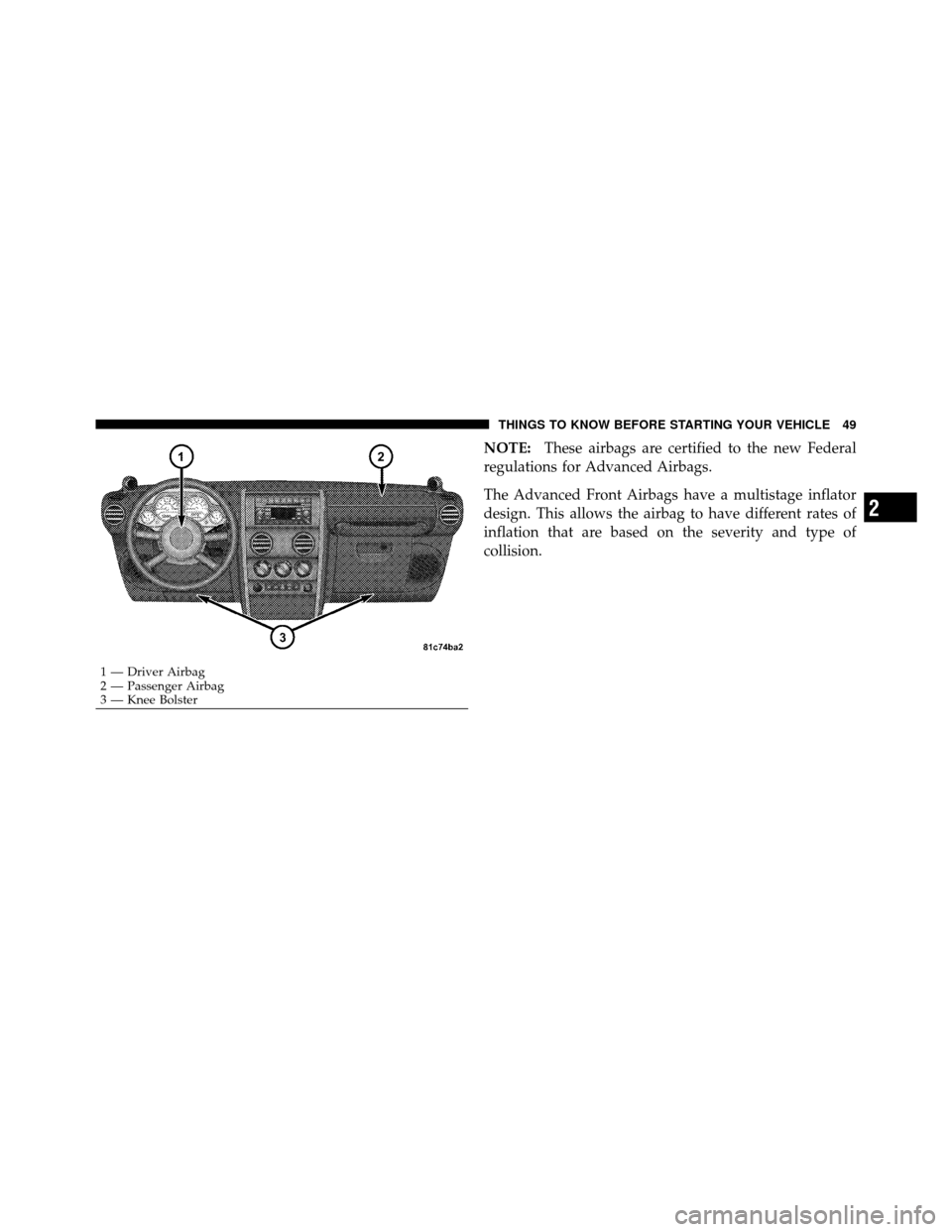
NOTE:These airbags are certified to the new Federal
regulations for Advanced Airbags.
The Advanced Front Airbags have a multistage inflator
design. This allows the airbag to have different rates of
inflation that are based on the severity and type of
collision.
1 — Driver Airbag
2 — Passenger Airbag
3 — Knee Bolster
2
THINGS TO KNOW BEFORE STARTING YOUR VEHICLE 49
Page 52 of 502
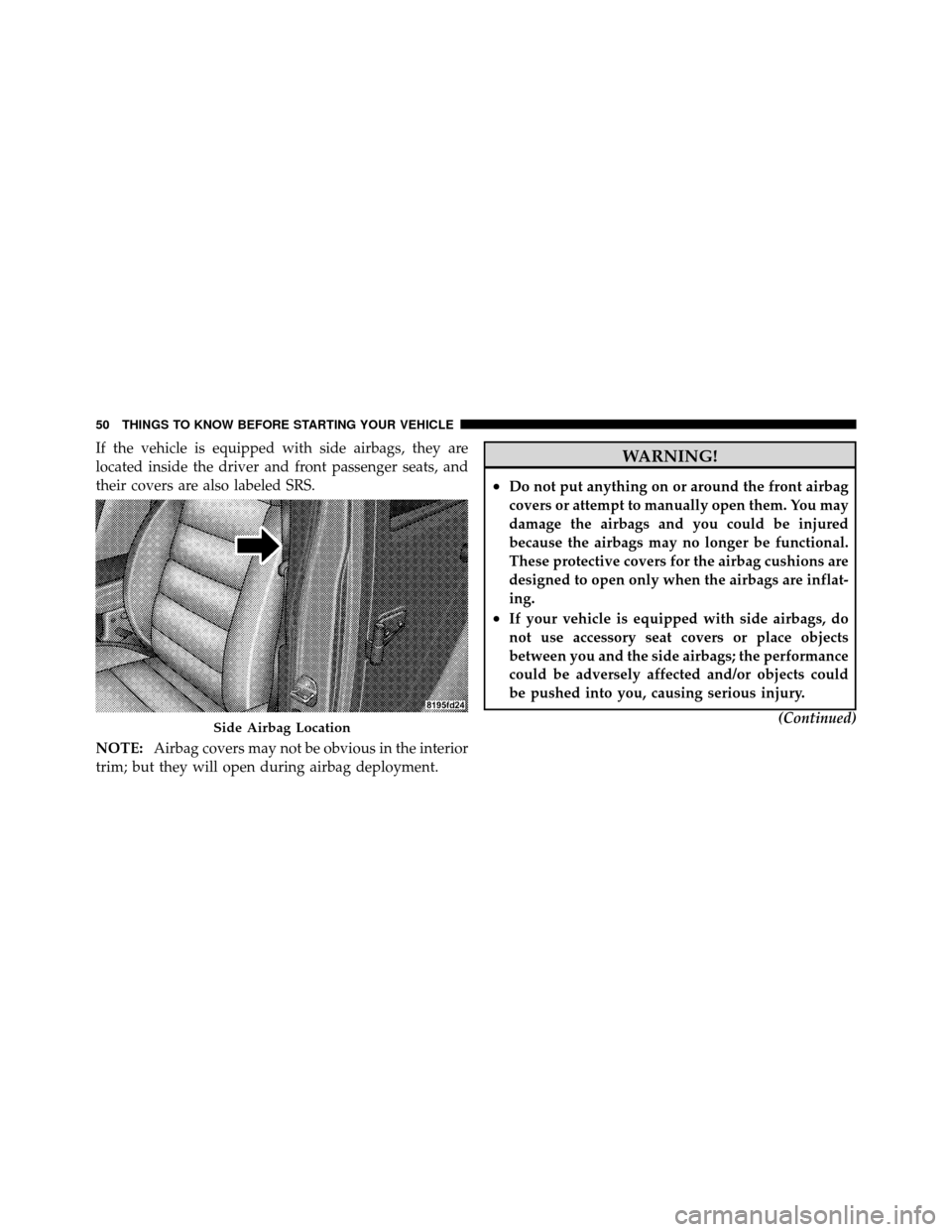
If the vehicle is equipped with side airbags, they are
located inside the driver and front passenger seats, and
their covers are also labeled SRS.
NOTE:Airbag covers may not be obvious in the interior
trim; but they will open during airbag deployment.WARNING!
•Do not put anything on or around the front airbag
covers or attempt to manually open them. You may
damage the airbags and you could be injured
because the airbags may no longer be functional.
These protective covers for the airbag cushions are
designed to open only when the airbags are inflat-
ing.
•If your vehicle is equipped with side airbags, do
not use accessory seat covers or place objects
between you and the side airbags; the performance
could be adversely affected and/or objects could
be pushed into you, causing serious injury.
(Continued)
Side Airbag Location
50 THINGS TO KNOW BEFORE STARTING YOUR VEHICLE
Page 53 of 502
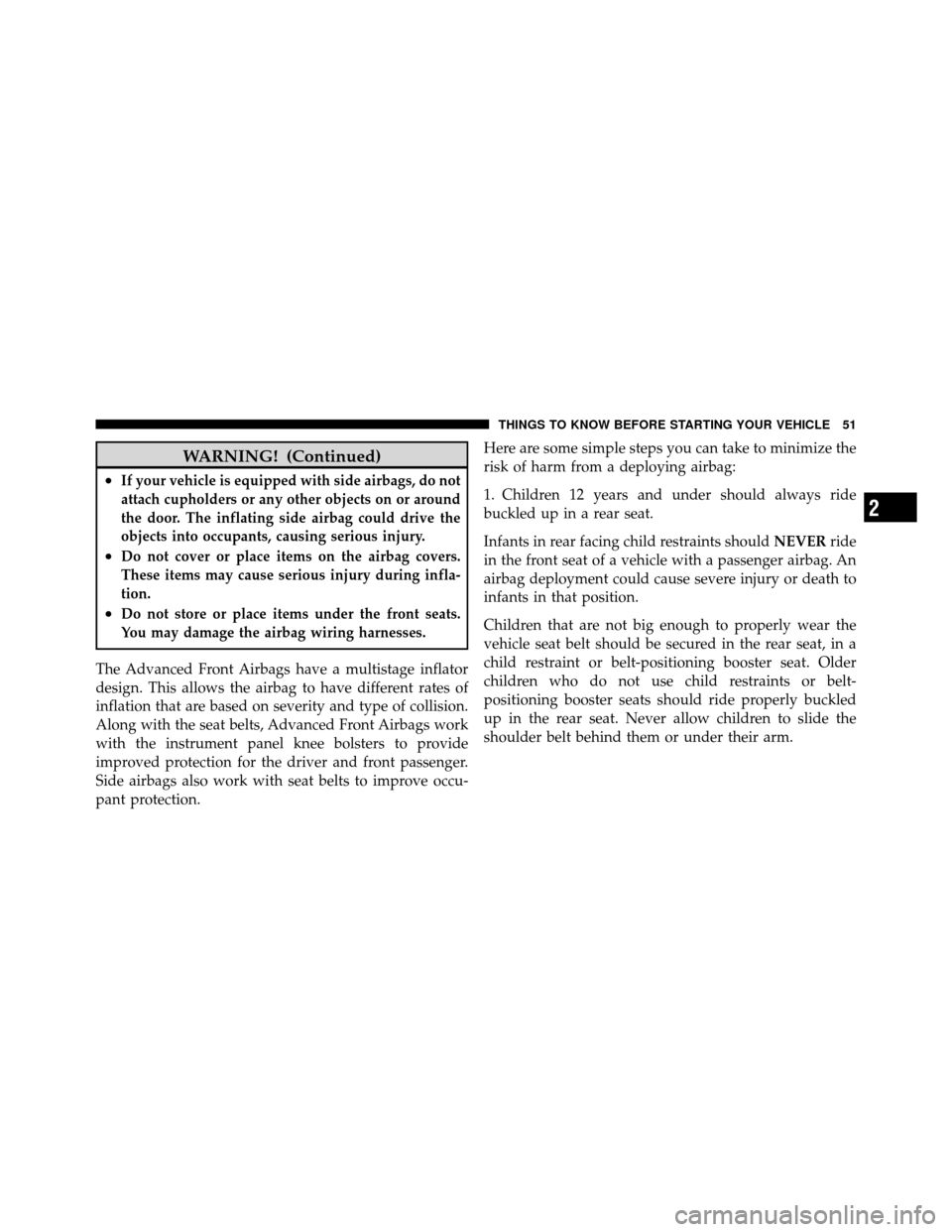
WARNING! (Continued)
•If your vehicle is equipped with side airbags, do not
attach cupholders or any other objects on or around
the door. The inflating side airbag could drive the
objects into occupants, causing serious injury.
•Do not cover or place items on the airbag covers.
These items may cause serious injury during infla-
tion.
•Do not store or place items under the front seats.
You may damage the airbag wiring harnesses.
The Advanced Front Airbags have a multistage inflator
design. This allows the airbag to have different rates of
inflation that are based on severity and type of collision.
Along with the seat belts, Advanced Front Airbags work
with the instrument panel knee bolsters to provide
improved protection for the driver and front passenger.
Side airbags also work with seat belts to improve occu-
pant protection.Here are some simple steps you can take to minimize the
risk of harm from a deploying airbag:
1. Children 12 years and under should always ride
buckled up in a rear seat.
Infants in rear facing child restraints should
NEVERride
in the front seat of a vehicle with a passenger airbag. An
airbag deployment could cause severe injury or death to
infants in that position.
Children that are not big enough to properly wear the
vehicle seat belt should be secured in the rear seat, in a
child restraint or belt-positioning booster seat. Older
children who do not use child restraints or belt-
positioning booster seats should ride properly buckled
up in the rear seat. Never allow children to slide the
shoulder belt behind them or under their arm.
2
THINGS TO KNOW BEFORE STARTING YOUR VEHICLE 51
Page 54 of 502
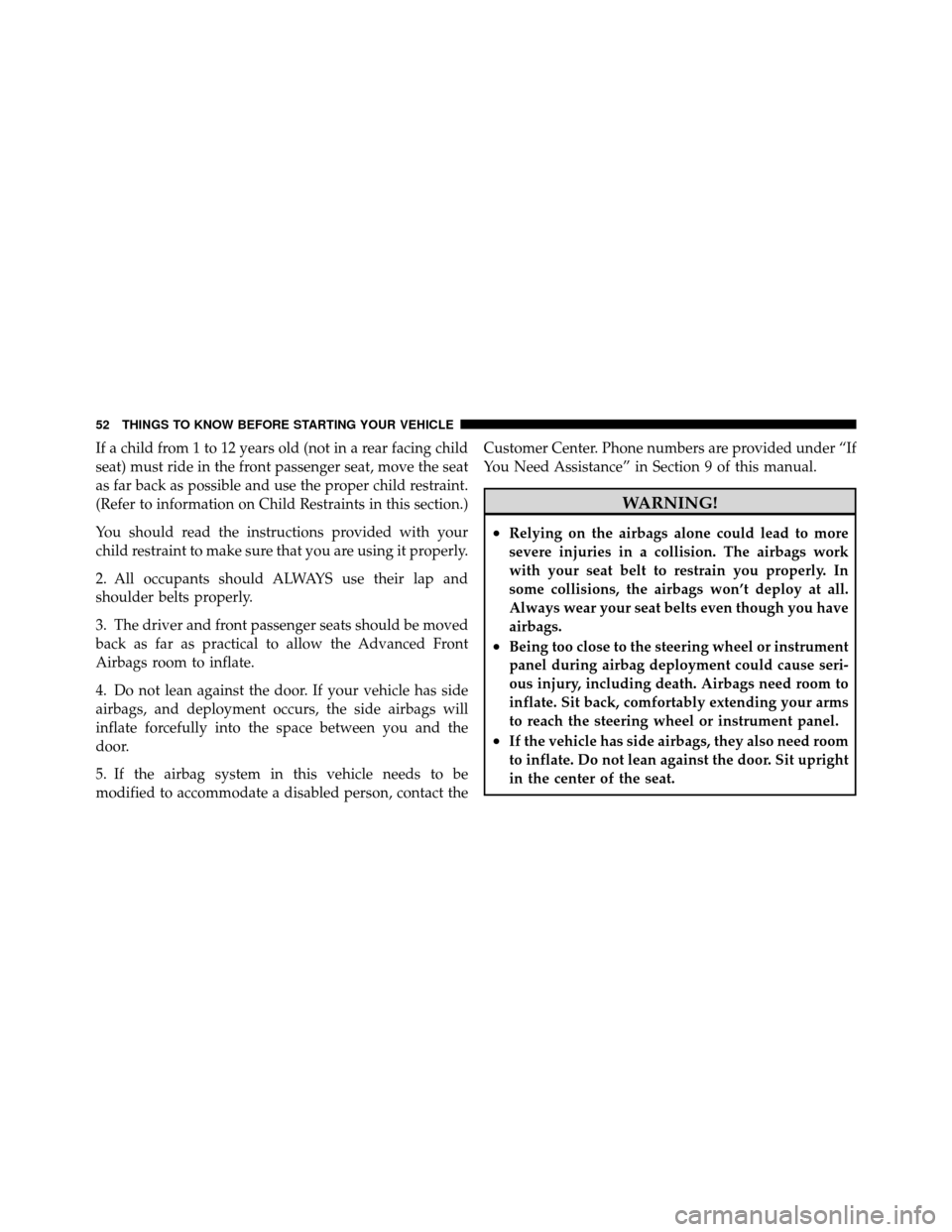
If a child from 1 to 12 years old (not in a rear facing child
seat) must ride in the front passenger seat, move the seat
as far back as possible and use the proper child restraint.
(Refer to information on Child Restraints in this section.)
You should read the instructions provided with your
child restraint to make sure that you are using it properly.
2. All occupants should ALWAYS use their lap and
shoulder belts properly.
3. The driver and front passenger seats should be moved
back as far as practical to allow the Advanced Front
Airbags room to inflate.
4. Do not lean against the door. If your vehicle has side
airbags, and deployment occurs, the side airbags will
inflate forcefully into the space between you and the
door.
5. If the airbag system in this vehicle needs to be
modified to accommodate a disabled person, contact theCustomer Center. Phone numbers are provided under “If
You Need Assistance” in Section 9 of this manual.
WARNING!
•Relying on the airbags alone could lead to more
severe injuries in a collision. The airbags work
with your seat belt to restrain you properly. In
some collisions, the airbags won’t deploy at all.
Always wear your seat belts even though you have
airbags.
•Being too close to the steering wheel or instrument
panel during airbag deployment could cause seri-
ous injury, including death. Airbags need room to
inflate. Sit back, comfortably extending your arms
to reach the steering wheel or instrument panel.
•If the vehicle has side airbags, they also need room
to inflate. Do not lean against the door. Sit upright
in the center of the seat.
52 THINGS TO KNOW BEFORE STARTING YOUR VEHICLE
Page 55 of 502
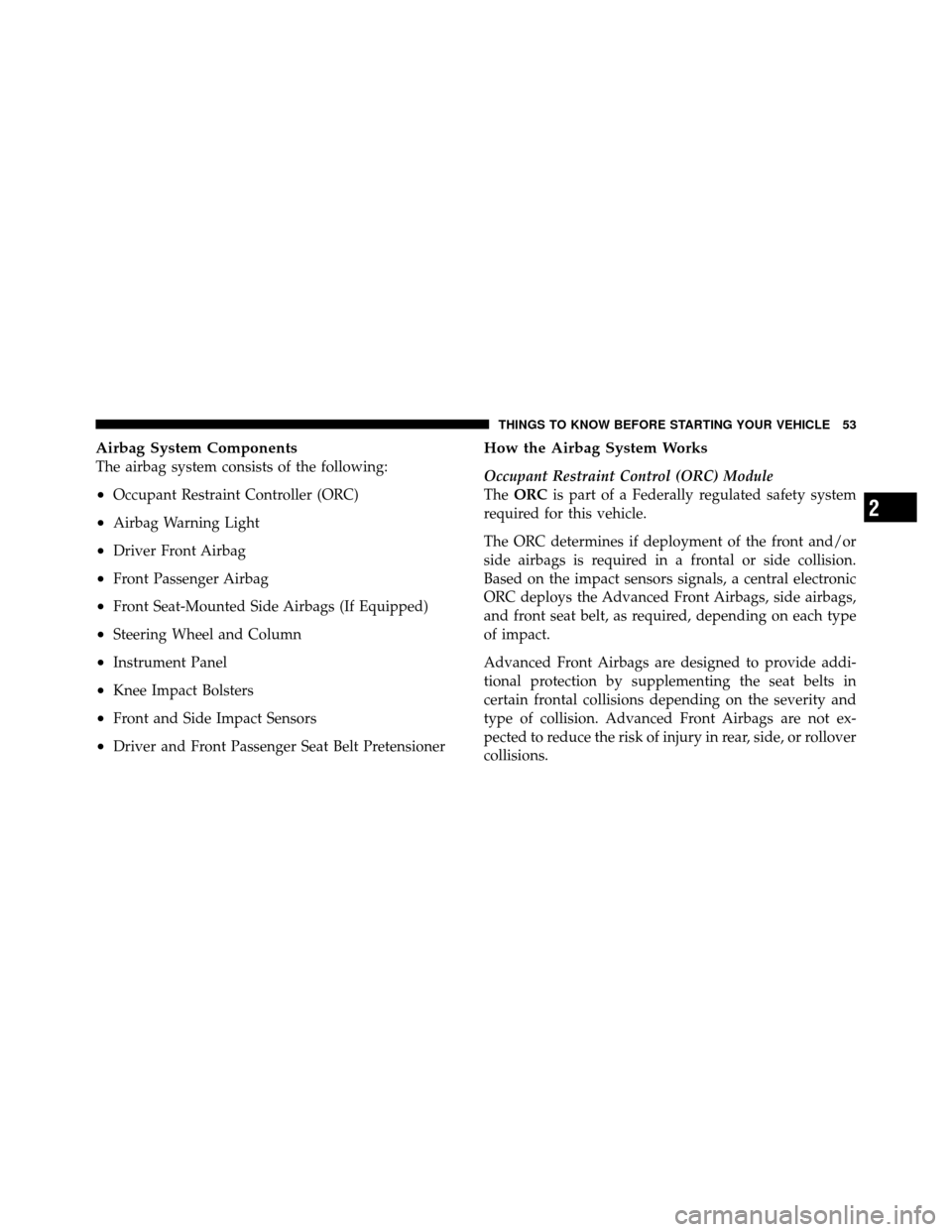
Airbag System Components
The airbag system consists of the following:
•Occupant Restraint Controller (ORC)
•Airbag Warning Light
•Driver Front Airbag
•Front Passenger Airbag
•Front Seat-Mounted Side Airbags (If Equipped)
•Steering Wheel and Column
•Instrument Panel
•Knee Impact Bolsters
•Front and Side Impact Sensors
•Driver and Front Passenger Seat Belt Pretensioner
How the Airbag System Works
Occupant Restraint Control (ORC) Module
TheORC is part of a Federally regulated safety system
required for this vehicle.
The ORC determines if deployment of the front and/or
side airbags is required in a frontal or side collision.
Based on the impact sensors signals, a central electronic
ORC deploys the Advanced Front Airbags, side airbags,
and front seat belt, as required, depending on each type
of impact.
Advanced Front Airbags are designed to provide addi-
tional protection by supplementing the seat belts in
certain frontal collisions depending on the severity and
type of collision. Advanced Front Airbags are not ex-
pected to reduce the risk of injury in rear, side, or rollover
collisions.
2
THINGS TO KNOW BEFORE STARTING YOUR VEHICLE 53
Page 56 of 502
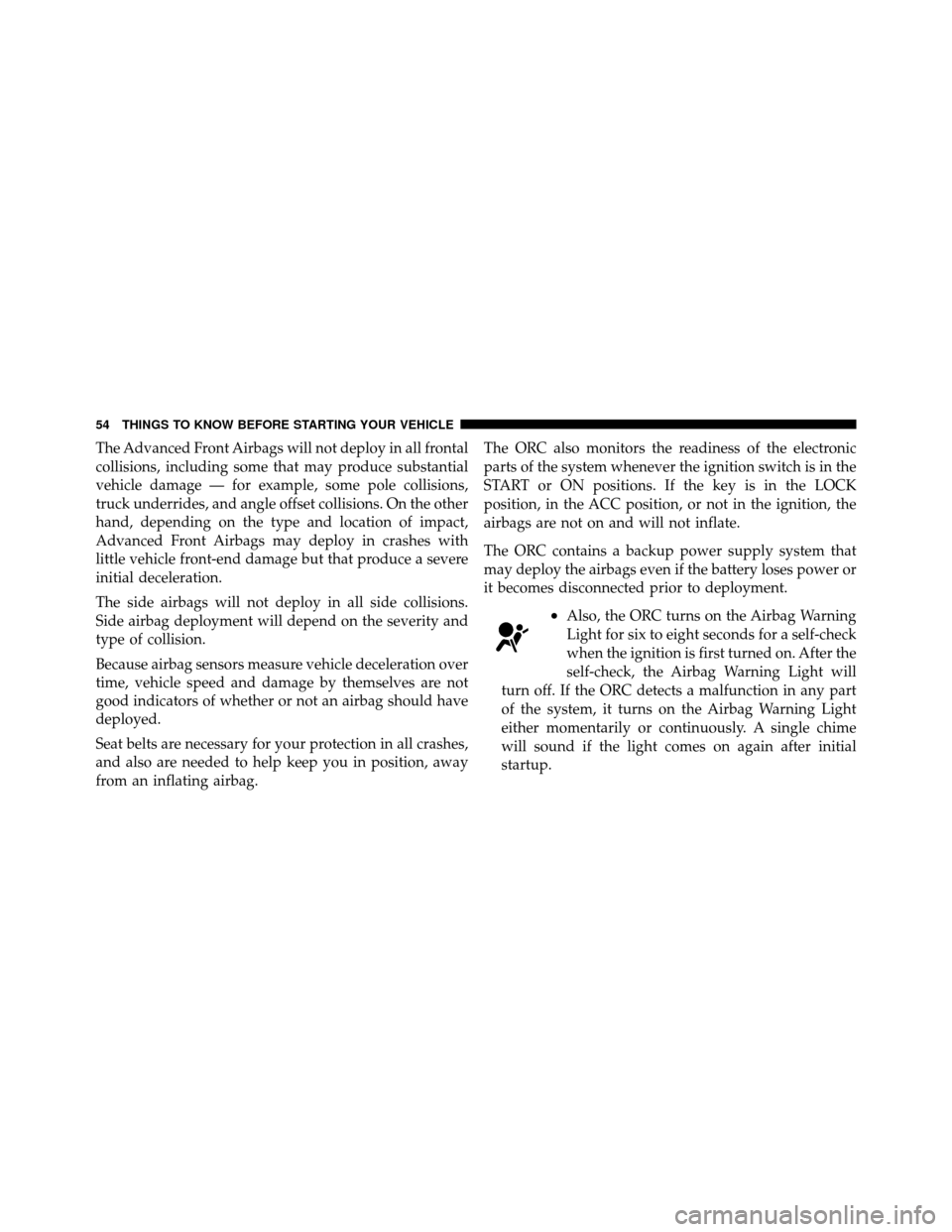
The Advanced Front Airbags will not deploy in all frontal
collisions, including some that may produce substantial
vehicle damage — for example, some pole collisions,
truck underrides, and angle offset collisions. On the other
hand, depending on the type and location of impact,
Advanced Front Airbags may deploy in crashes with
little vehicle front-end damage but that produce a severe
initial deceleration.
The side airbags will not deploy in all side collisions.
Side airbag deployment will depend on the severity and
type of collision.
Because airbag sensors measure vehicle deceleration over
time, vehicle speed and damage by themselves are not
good indicators of whether or not an airbag should have
deployed.
Seat belts are necessary for your protection in all crashes,
and also are needed to help keep you in position, away
from an inflating airbag.The ORC also monitors the readiness of the electronic
parts of the system whenever the ignition switch is in the
START or ON positions. If the key is in the LOCK
position, in the ACC position, or not in the ignition, the
airbags are not on and will not inflate.
The ORC contains a backup power supply system that
may deploy the airbags even if the battery loses power or
it becomes disconnected prior to deployment.
•Also, the ORC turns on the Airbag Warning
Light for six to eight seconds for a self-check
when the ignition is first turned on. After the
self-check, the Airbag Warning Light will
turn off. If the ORC detects a malfunction in any part
of the system, it turns on the Airbag Warning Light
either momentarily or continuously. A single chime
will sound if the light comes on again after initial
startup.
54 THINGS TO KNOW BEFORE STARTING YOUR VEHICLE
Page 57 of 502
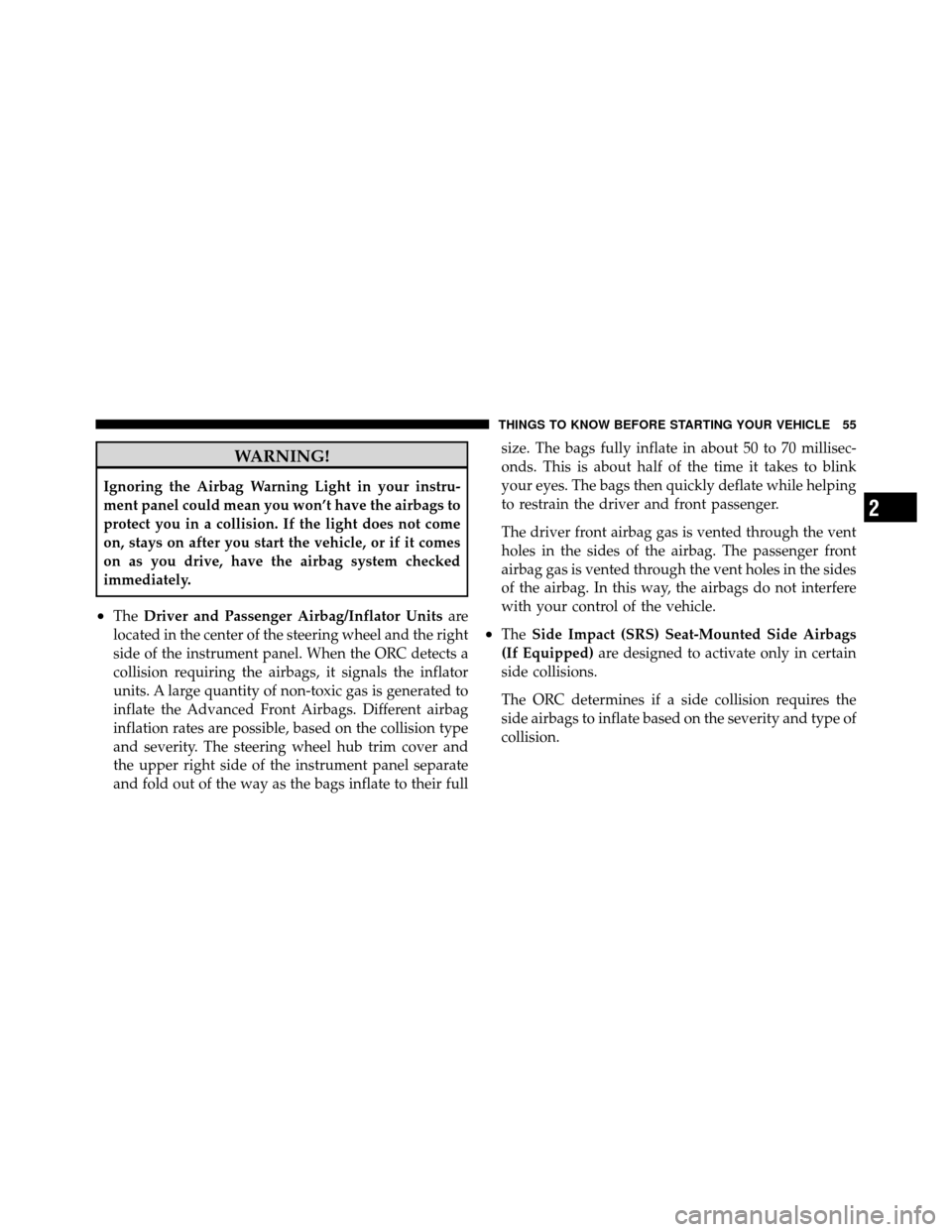
WARNING!
Ignoring the Airbag Warning Light in your instru-
ment panel could mean you won’t have the airbags to
protect you in a collision. If the light does not come
on, stays on after you start the vehicle, or if it comes
on as you drive, have the airbag system checked
immediately.
•TheDriver and Passenger Airbag/Inflator Units are
located in the center of the steering wheel and the right
side of the instrument panel. When the ORC detects a
collision requiring the airbags, it signals the inflator
units. A large quantity of non-toxic gas is generated to
inflate the Advanced Front Airbags. Different airbag
inflation rates are possible, based on the collision type
and severity. The steering wheel hub trim cover and
the upper right side of the instrument panel separate
and fold out of the way as the bags inflate to their full size. The bags fully inflate in about 50 to 70 millisec-
onds. This is about half of the time it takes to blink
your eyes. The bags then quickly deflate while helping
to restrain the driver and front passenger.
The driver front airbag gas is vented through the vent
holes in the sides of the airbag. The passenger front
airbag gas is vented through the vent holes in the sides
of the airbag. In this way, the airbags do not interfere
with your control of the vehicle.
•The
Side Impact (SRS) Seat-Mounted Side Airbags
(If Equipped) are designed to activate only in certain
side collisions.
The ORC determines if a side collision requires the
side airbags to inflate based on the severity and type of
collision.
2
THINGS TO KNOW BEFORE STARTING YOUR VEHICLE 55
Page 58 of 502
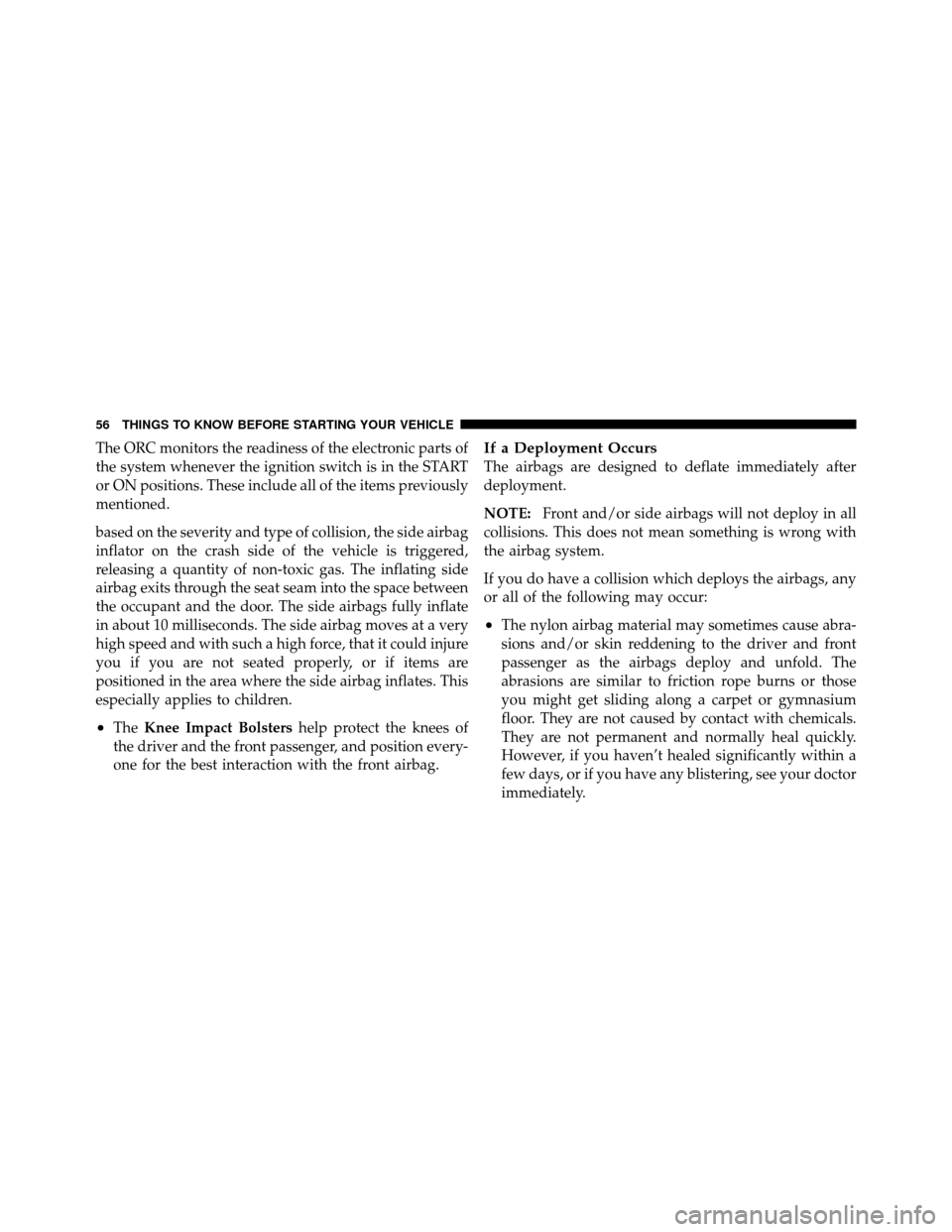
The ORC monitors the readiness of the electronic parts of
the system whenever the ignition switch is in the START
or ON positions. These include all of the items previously
mentioned.
based on the severity and type of collision, the side airbag
inflator on the crash side of the vehicle is triggered,
releasing a quantity of non-toxic gas. The inflating side
airbag exits through the seat seam into the space between
the occupant and the door. The side airbags fully inflate
in about 10 milliseconds. The side airbag moves at a very
high speed and with such a high force, that it could injure
you if you are not seated properly, or if items are
positioned in the area where the side airbag inflates. This
especially applies to children.
•TheKnee Impact Bolsters help protect the knees of
the driver and the front passenger, and position every-
one for the best interaction with the front airbag.
If a Deployment Occurs
The airbags are designed to deflate immediately after
deployment.
NOTE: Front and/or side airbags will not deploy in all
collisions. This does not mean something is wrong with
the airbag system.
If you do have a collision which deploys the airbags, any
or all of the following may occur:
•The nylon airbag material may sometimes cause abra-
sions and/or skin reddening to the driver and front
passenger as the airbags deploy and unfold. The
abrasions are similar to friction rope burns or those
you might get sliding along a carpet or gymnasium
floor. They are not caused by contact with chemicals.
They are not permanent and normally heal quickly.
However, if you haven’t healed significantly within a
few days, or if you have any blistering, see your doctor
immediately.
56 THINGS TO KNOW BEFORE STARTING YOUR VEHICLE
Page 59 of 502
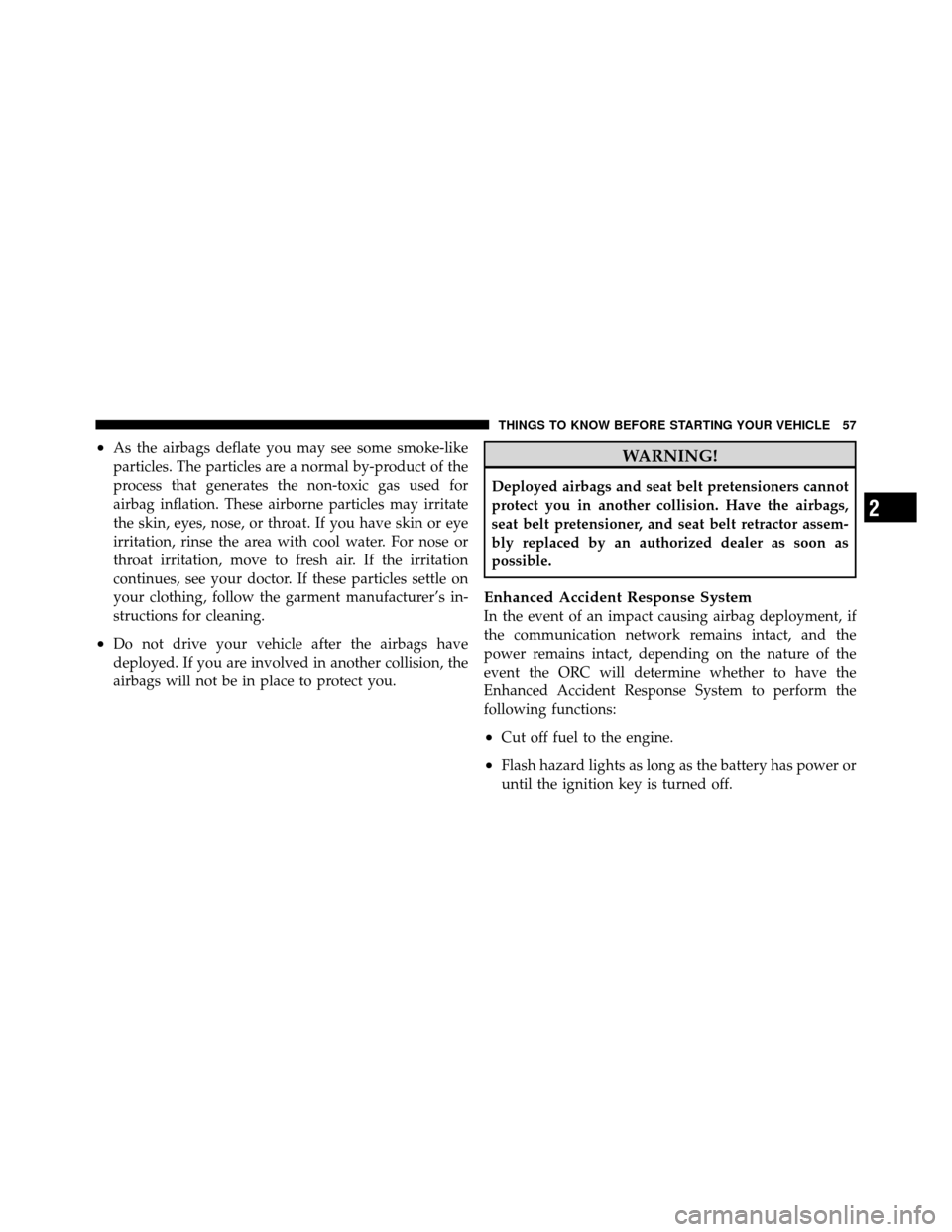
•As the airbags deflate you may see some smoke-like
particles. The particles are a normal by-product of the
process that generates the non-toxic gas used for
airbag inflation. These airborne particles may irritate
the skin, eyes, nose, or throat. If you have skin or eye
irritation, rinse the area with cool water. For nose or
throat irritation, move to fresh air. If the irritation
continues, see your doctor. If these particles settle on
your clothing, follow the garment manufacturer’s in-
structions for cleaning.
•Do not drive your vehicle after the airbags have
deployed. If you are involved in another collision, the
airbags will not be in place to protect you.
WARNING!
Deployed airbags and seat belt pretensioners cannot
protect you in another collision. Have the airbags,
seat belt pretensioner, and seat belt retractor assem-
bly replaced by an authorized dealer as soon as
possible.
Enhanced Accident Response System
In the event of an impact causing airbag deployment, if
the communication network remains intact, and the
power remains intact, depending on the nature of the
event the ORC will determine whether to have the
Enhanced Accident Response System to perform the
following functions:
•Cut off fuel to the engine.
•Flash hazard lights as long as the battery has power or
until the ignition key is turned off.
2
THINGS TO KNOW BEFORE STARTING YOUR VEHICLE 57
Page 60 of 502
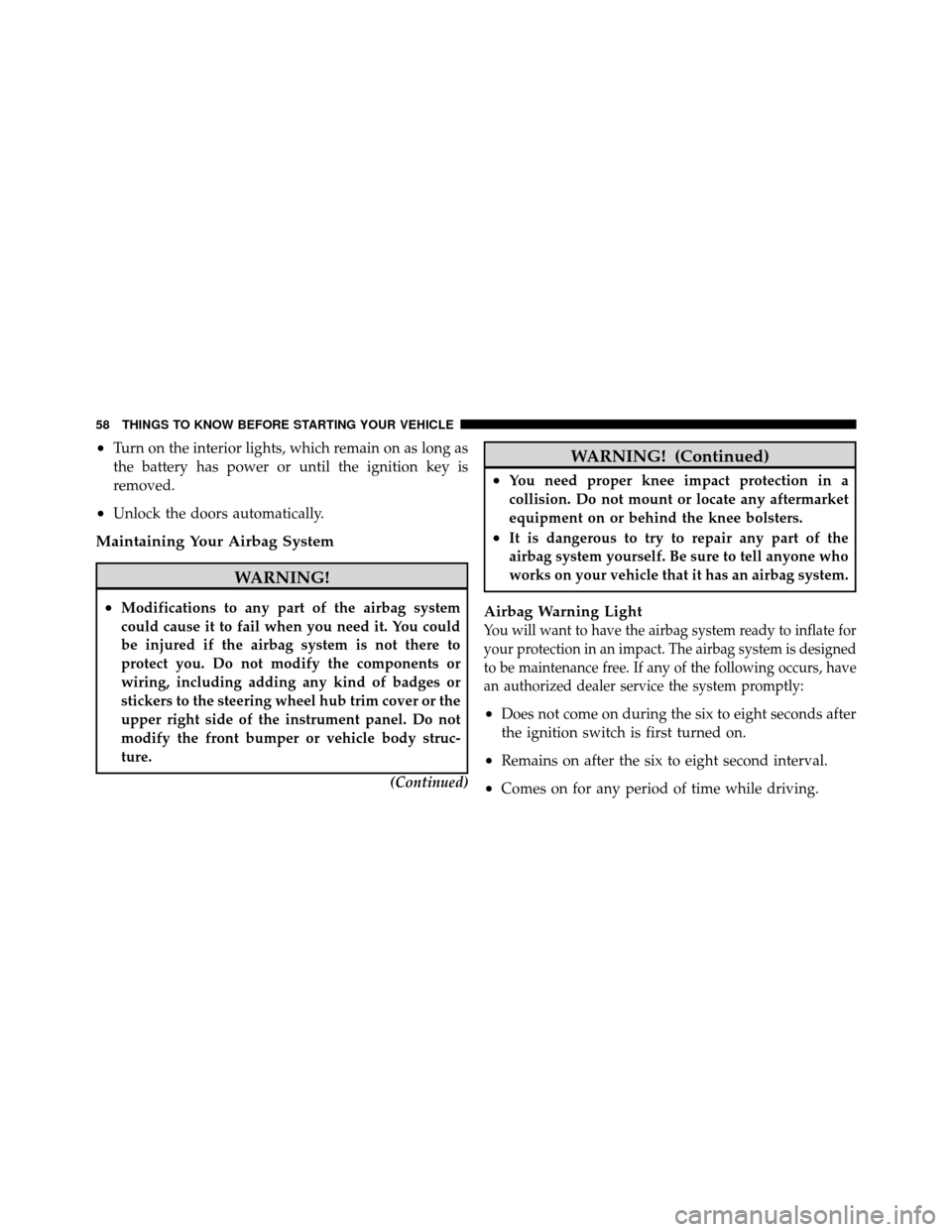
•Turn on the interior lights, which remain on as long as
the battery has power or until the ignition key is
removed.
•Unlock the doors automatically.
Maintaining Your Airbag System
WARNING!
•Modifications to any part of the airbag system
could cause it to fail when you need it. You could
be injured if the airbag system is not there to
protect you. Do not modify the components or
wiring, including adding any kind of badges or
stickers to the steering wheel hub trim cover or the
upper right side of the instrument panel. Do not
modify the front bumper or vehicle body struc-
ture.(Continued)
WARNING! (Continued)
•You need proper knee impact protection in a
collision. Do not mount or locate any aftermarket
equipment on or behind the knee bolsters.
•It is dangerous to try to repair any part of the
airbag system yourself. Be sure to tell anyone who
works on your vehicle that it has an airbag system.
Airbag Warning Light
You will want to have the airbag system ready to inflate for
your protection in an impact. The airbag system is designed
to be maintenance free. If any of the following occurs, have
an authorized dealer service the system promptly:
•Does not come on during the six to eight seconds after
the ignition switch is first turned on.
•Remains on after the six to eight second interval.
•Comes on for any period of time while driving.
58 THINGS TO KNOW BEFORE STARTING YOUR VEHICLE